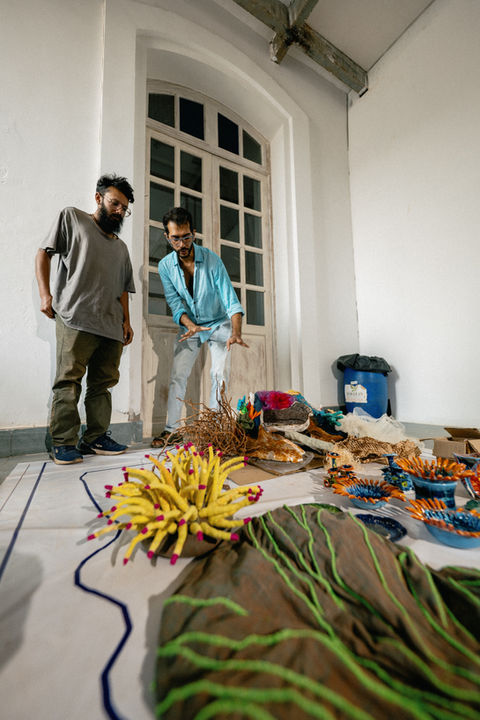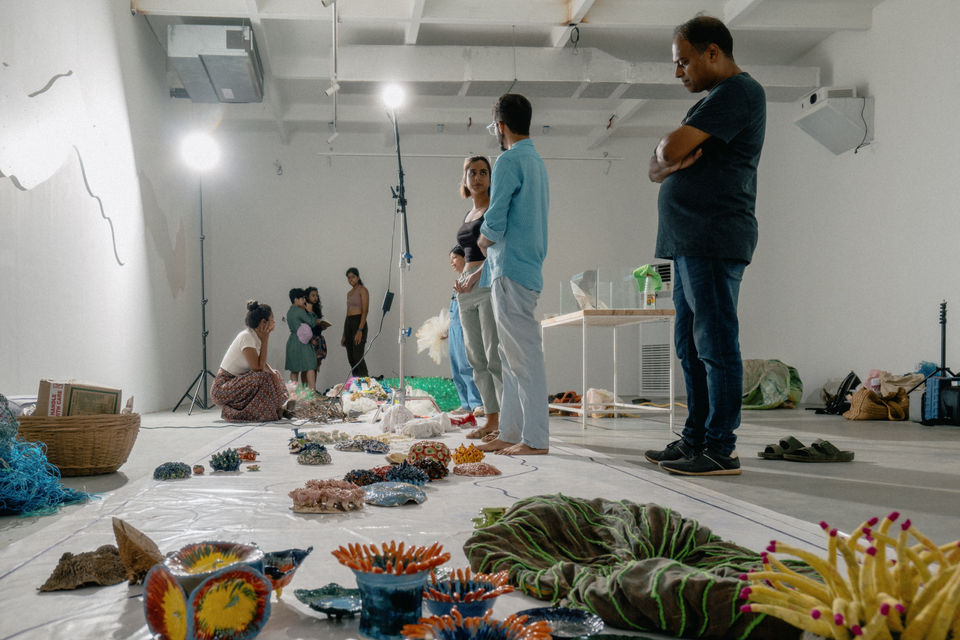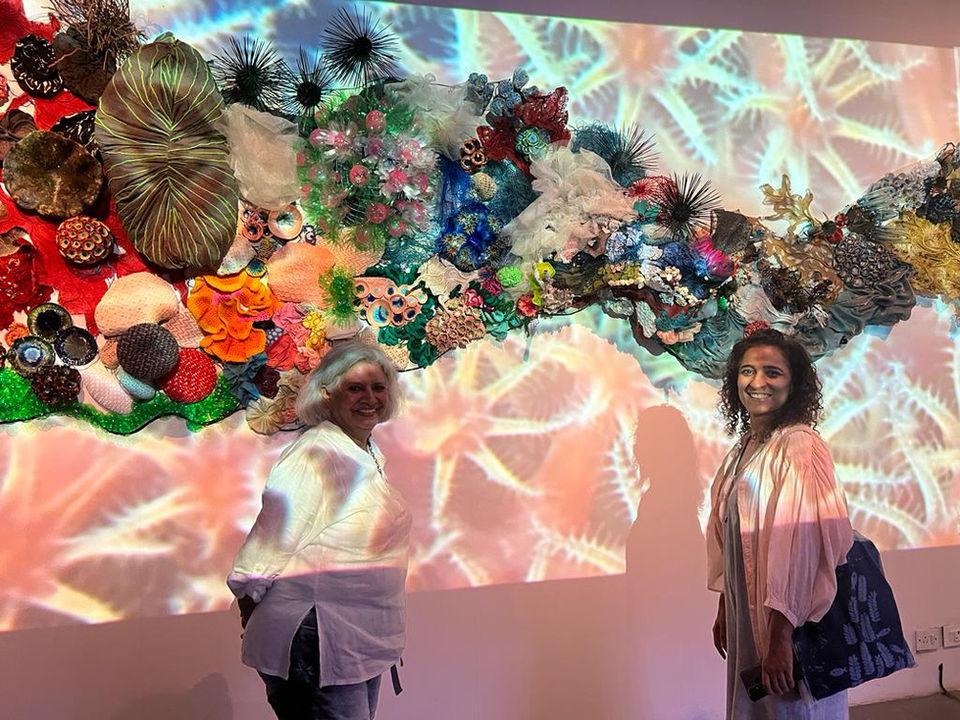DESING
DESING



Art

Art for Awareness
I use art as a medium to address these human influenced shifts in the ecosystem and the lenses of design and science to create modular remedies to currently fit on to existing modes of development
Tracing imbalances created by the anthropocene, and exploring symbiotic relationships between science, design, anthropology, mythology and environmental disciplines.
Waylon produces objects and artworks that contemplate the multi-dimensional aspects of ecology within a paradoxical contemporary framework. His practice translates both personal observation and technical data into aesthetically constructed devices that communicate and propose solutions.
His current artistic commentaries address marine biodiversity in particular, and the manner in which relentless capitalism and consumerism are contaminating, fragmenting and destroying these eco-zones that are crucial to survival.
Utilising visual and factual information gathered from varied sites and landscapes, he builds conscious patterns that reflect the fundamental elements of the universe itself. Notions of interdependence of species, the retaliation of nature under pressure, and numerous truths that the economic world appears blind and deaf to, appear as prominent threads of discourse throughout his work.
Waylon has developed a language of expression that allows these harsh commentaries to be represented as symbolic design narratives, that provoke thought and linger in the viewer’s conscience.
- Lina Vincent Sunish

Blue Carbon
Serendipity arts festival 2023
Metropolyp
A multidisciplinary and interactive, process driven art installation on conversations between corals and the capitalocene

Corals have endured through millennia and have formed the architecture and a bustling metropolis that not only supports lifestyles and proliferation of 25 % of marine species, they sequester carbon and agents of biocalcification.

Coincidentally our very own metropolises use the very same main elements carbon and calcium for structure and energy but ironically, through its morphology and methods it has led to destruction and loss of biodiversity in its wake.

I embarked on inviting scientists, researchers, architects, artists, teachers, engineers, divers and designers recreate a coral reef, where they act together as different species forming a seamless ecosystem, through integration instead of separation.
The participants engaged in resource sharing , recycling , and their intellectual, ideological, cultural and aesthetic get assimilated into the whole which is greater then the sum of its parts

This element is a form of community engagement and conversation around blue carbon, corals and climate by bringing together different practitioners and artists in a participatory, palpable and celebratory curated potluck assemblage of a spectrum of traditional mediums and new age AI and mathematical generated art.
This creates diversity in transient perspectives of displacement and occupation by understanding of the human and coral evolutionary interfaces
Unlike traditional practices of designated walls areas for different artists , here the participents have to have their works merge, overlap and grow together.

Co-creators
Sparsh Gupta, Kirity Sinha, Simar Puneet, Ape Chronicle Media
Vaishali S, Nimmi Joshi and Clayton Dsouza
Shrutii and Celestin Mascarenhas, Ian Anderson
Musharaff Hebballi, Sepia stories, Mrig, Blanche Mendonca,
Klove studio, Mansi Trivedi and Tenzin Gopal
Partha Patil, Meesha Holley, Kristoff Braganca Dhruv Athreye and Bala Malaivendan
Charmaine Pereira, , Danika Tavora, Coral woman Impact, Akansha Tiwari
Mrinalini Deshprabhu, Jennifer Parras, Aru Bose, Aaina and the Margaryan kids, Kimberley do Rego, Lucy Peres.

Reef-building corals, which reproduce through simultaneous multispecies spawning, are thought to hybridize frequently, and it is hypothesized that they have evolved in repeated rounds of species separation and fusion. Through cross-fertilization experiments and molecular analyses with a number of mass-spawning coral species, A high rate of interspecific fertilization occurred between some species despite very different morphologies have been observed.These reproductive and genetic characteristics are consistent with a species complex formed under the separation/fusion processes predicted for a reticulate evolutionary history.

Climate anxiety accretion aquarium
The aquarium incubates the intersection of science, evolution through various interactive technological, chemical and biological media. In it extrapolations lie genetic diversity of possibilities through cross pollination of various data patterns, human perspectives and practices on coral research and restoration practices

The video projections juxtapose the coral life and urban statistics on a timeline.
The interactive aspect switches from and macro coral growth, behavior and consumption processes to anthropogenic growth, practices and disturbances like pollution and competitive displacement, as the viewer walks through the installation.

Global waters
Culture ad consumerism, The Ferris wheel of carbon wars and pursuit of digital immortality.
In 2020 for the changwon sculpture biennale in south korea I created a sensory scape brings together aspects or maritime trade, oil with whale communication and Buddhism
I collaborated with music producers, scientists and sailors all over the world to create this understanding of a global ecosystem.

Echos in Eternal return - Changwon Sculpture Biennale, 2020
Writer & Director - Waylon James D'souza
Sound & Video Editor - KAFN
Plankton Videography - Prof. Igor Adameyko (Medical University of Vienna - Brain Research Center)
Photography - Ian Jones, biomedical scientist, Geneva.
Whale Audio Contributor - Fred Sharpe (Sounds collected under NMFS Research Permit No. 19703)
Special thanks to - Lindy Weilgart, Divya Panickar
.png)
The phytoplankton as a metaphor and opposite of the sun, cymaglyphs and Buddhists mandalas echo the traditional eternal return along with new disruptive beats of seismic guns and the optic cable rabbit holes of future consciousness or accelerated collapse through drowning of 'non-human' aural diversity.
As man dived deep for more energy to consume, he circumnavigated the oceans to communicate and trade further. The Morse code that evolved from this endeavor became a crucial communication tool during world war 2.
Sperm whales developed a Morse code like language millions of years ago in their pursuit of churning the elements, in assisting the superorganism that is the ocean. They see their environment through sound in the absence of light.
The ocean has intricately cradled cultures that human civilization is only beginning to decipher and decode.
India’s past, present and future
Rivers are arteries and veins of the land, civilizations rose and fell at the will or abuse of rivers
Arterial blockages in the the Anthropocene

I went on to understand water in intercontinental ecosystems, in this mandala for mumbai art room i went back in time how india crashed into Eurasia and how the third pole was formed, the evolution of river godesses vahanas , showing damming of rivers, consumerism , industrial monoculture and the future
Mutarerium, Mumbai Art Room 2019, Curated by Adwait Singh
Materials : Print on hemp fabric, ghost nets, marine flotsam and shells, Dimensions : 7ft x 6ft x 3ft

The Cascade of Futures Past employs an old idiom from Indian sacred geography – the mandala – to yarn the evolution of Gangetic dolphin from a land dweller, Pakicetus to the long snouted cetacean, starting around the same time as the gradual elevation of the Tethys sea into the Himalayan watershed. The mandala format enables a collation of different vantages – paleontological, climatological, geological, biological, anthropological and mythical – as well as a circular view of time.
The species has become severely threatened on account of damming and other riverine activities by humans which disrupt its biological cycles. Through a diagrammatic compression of the various factors at play, the artist hopes to convey a more comprehensive picture that can inform our conservation praxis. The need for a transnational, integrated conservation effort articulated from a fisheye perspective, is expressed through a melange of different national flags corresponding to countries that share the Himalayan watershed.

At the heart of the work lies the goddess Ganga astride her vanishing vahana. This together with the cities and communities flanking her are indicators of ecological practices/ formulations that have become quite divorced from their significance, as well as the exigency of involving local communities in conservation and policy making.
On her lota and above the dam there are bacteriophages linking how, for centuries, she has been revered for her “self-cleansing and special healing properties”
Despite of pollution created by human, the river Ganga supports a wide diversity due to
its self-cleaning and regeneration properties.
Studies in 1896 by British bacteriologist Ernest Hankin showed the antimicrobial properties of river Ganga against Vibrio cholera, causative agent of cholera which gets destroyed in Ganga water but thrived in tapwater.After a decade in 1916 Felix d’ Herelle, a French Canadian microbiologist proposed that it was virus that parasitized bacteria which he termed as a Bacteriophage, the prokaryotic viruses that solely infect and/ or destroy the bacteria.
Could Virophages and bacteriophages trapped at a much earlier time scale in the Himalayan permafrost be

The Foundations of a State
Water plays a central and critical role in all aspects of life – in the national environment, in our economies, in food security, in production, in politics. Water has indeed a special significance for the great religions.
With my installations I hope to touch upon current development or consumption in the state that we unknowingly revere as new symbols to edify, while forcefully acknowledgement of the older ecosystems that provide us with intangible benifits of clean air, water and food that are displaced into history, things we admire or has tied culture, ecology and local economics into resilience.
Now there is replacement of these local resource benefits that are currently not credited in mainstream 'Quality of life' economics, with homogenization. Here the Indian humpback dolphin is used as the poster child of coastal life whose backbone is dissected by the scaping of state arteries, fragmented by an arena of shareholders to produce the iconography we shall inherit.
In the three reciprocal installations that can be viewed together or in segments, Waylon integrates his personal study of the sentient marine beings that share space with humans, along with a critical interpretations of the hazards of contemporary industry and living.

Azulejos - Mundo Goa, Serendipity 2019
This process-driven exhibition features 25 Goa-based artists at the heritage headquarters of Instituto Camões (IC) at the Casa Basilio Dias on the Panjim waterfront, to study and learn about the iconic Islamic-Iberian ceramic tile-work that has spread in innumerable beautiful manifestations all over the world. They received a grounding in the art history of the Indo-European encounter triggered through Goa, leading up to their own position in this continuum, in order to produce twenty-first century azulejos in various mediums.
Here the Indian humpback dolphin is used as the poster child of coastal life whose backbone is dissected by the scaping of state arteries, fragmented by an arena of shareholders to produces the iconography we shall inherit.

Part II is a photomontage that brings together snapshots of shore-scapes, found objects (from dolphin bones to gill and ghost nets, plastic waste to delivery cartons) and views of the status of surf and sand at varied locations across the coast of south west India. The discontinuous and yet interconnected series of images tell a story of our times and the notion of ‘development’ and progress, as seen in the (non-biodegradable) residues of human habitation and commerce.
materials- photo prints on paper - A journey from north to south goa, observances and found objects that were used in the making of derivations in part 3 of the installation.( 2 photos from bombay and kerala to construct the story, also iterating phenomenons and issues on the west cost as a whole.) - 27 photos
The imagery builds a dialogue between the central form of the creature and its surrounding imagery of symbolically manipulated designs that are derived from harmful activities and attitudes reflecting contemporary reality.
Closer viewing reveals a kaleidoscopic view starting with the underside of bridges, JCB heavy machinery and JCPs digging away at the goan topography to widespread infrastructure development and unmitigated urban expansion.
In sucession trawlers, ghost nets and a flipcart bag washed up on a beach symbolise our consumerism.
.png)


Similarly iron ore barges from mining and coal transport,one of the causes of mercury content increasing in oysters which are vacuum cleaners of the coasts is signified as the roman god of of financial gain, commerce, eloquence, travelers, boundaries, luck, trickery and thieves.
“The South West monsoon produces an oxygen minimum zone in the Arabian Sea and this seasonal oxygen deficiency might cause the sulphur reducing bacteria to produce methylmercury,This could enter our food chain through the fish we eat and cause something known as the Minamata disease.”- Dr Parthasarthi Chakraborty





































































